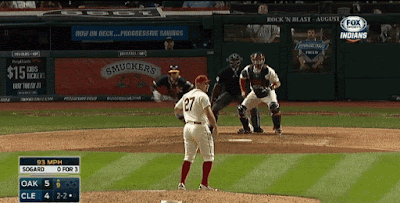Lindor was called up on June 14, 2015 and has since played
86 games posting a Wins Above Replacement of 3.8, while Correa was called up on
June 8, 2015 and has since played 87 games posting a Wins Above Replacement of
2.7. If you look at some other offensive
metrics however they are neck and neck, such as they both have a wOBA of .357. Then if you look at weighted runs created
plus (wRC+) Lindor sits at 128, while Correa sits at 127. So while they are
both well above league average (28% and 27% respectively) only one of them can
win the award. As you can see they are
pretty equal in terms of overall offensive, with Correa maybe having the slight
advantage being a power hitting shortstop (18 HRs vs. Lindor’s 10 HR). But defense
is where Lindor takes home the award.
Too often people see web gems that players make and automatically
think that a guy must be a good defensive player. When in actuality there is no
correlation between the two and Carlos Correa is a prime example of this (at
least in 2015). For example, he has made
some of the best plays in baseball this year (as you can see below) but if you
look at the metrics he is a well below average defensive shortstop (once again at least in
2015) while Lindor is in that top tier.
The Cleveland Indians’ shortstops not named Francisco Lindor have a
combined to cost the Indians 1 run, while Lindor has saved 7 on his own, which
is good enough to rank fifth among all MLB shortstops, while Correa’s -2 would
be tied for 14th. Another advanced
defensive metric Ultimate Zone Rating (UZR) also shows just how good Lindor is
at fielding his position. Through 751.1
defensive innings he has a UZR of 6.7 which ranks 7th in all of
baseball. And if you adjust it per 150 defensive games he has a UZR/150 of 15.1
which ranks 5th in all of baseball.
Compare this to Correa who has a UZR of -4.1 which ranks 17th
and a UZR/150 of -10.9 which ranks 23rd, right ahead of Marcus
Semien of the Oakland Athletics who you will never hear anyone call a good
defensive player. Overall defensive
value ranks Lindor (10.5) first on the Indians, 8th among MLB
shortstops and 17th among all MLB players. While it ranks Correa
(-0.2) 28th on the Astros, 21st among MLB shortstops and
83rd among all MLB players. But
my absolute favorite Lindor statistic is his inside edge fielding, where he has
fielded 83.3% of the plays ruled unlikely (10-40% chance of being fielded),
77.8% of the plays ruled even (40-60% chance of being fielded), 100.0% of the
plays ruled likely (60-90% chance of being fielded) and 96.0% of the plays
ruled routine (90-100% chance of being fielded). While there is a 433 defensive innings difference
between Lindor and the consensus best defensive shortstop in all of baseball,
Andrelton Simmons, Lindor’s percentages are not only better but they blow
Simmons away in fact (unlikely: 30.0%, even: 33.3%, likely: 83.3%, routine:
99.5%). There is one exception to this and that is plays ruled remote (1-10% chance of being
fielded) where Lindor has not made any of these, Simmons has made 6.7% of them
in 2015. Then compare this to Correa who
has fielded 60% of the unlikely plays, 60% of the even plays, 81.8% of the
likely plays and 96.6% of the routine plays, in about the same number of
defensive innings.
Carlos Correa has the talent to be the top shortstop in Major
League Baseball and one of the elite players in baseball and in a few years
most likely will be. But for the moment Francisco Lindor is the all around
better player and the top rookie in the American League and it is for that
reason that he should win American League Rookie of the Year in 2015.






No comments:
Post a Comment